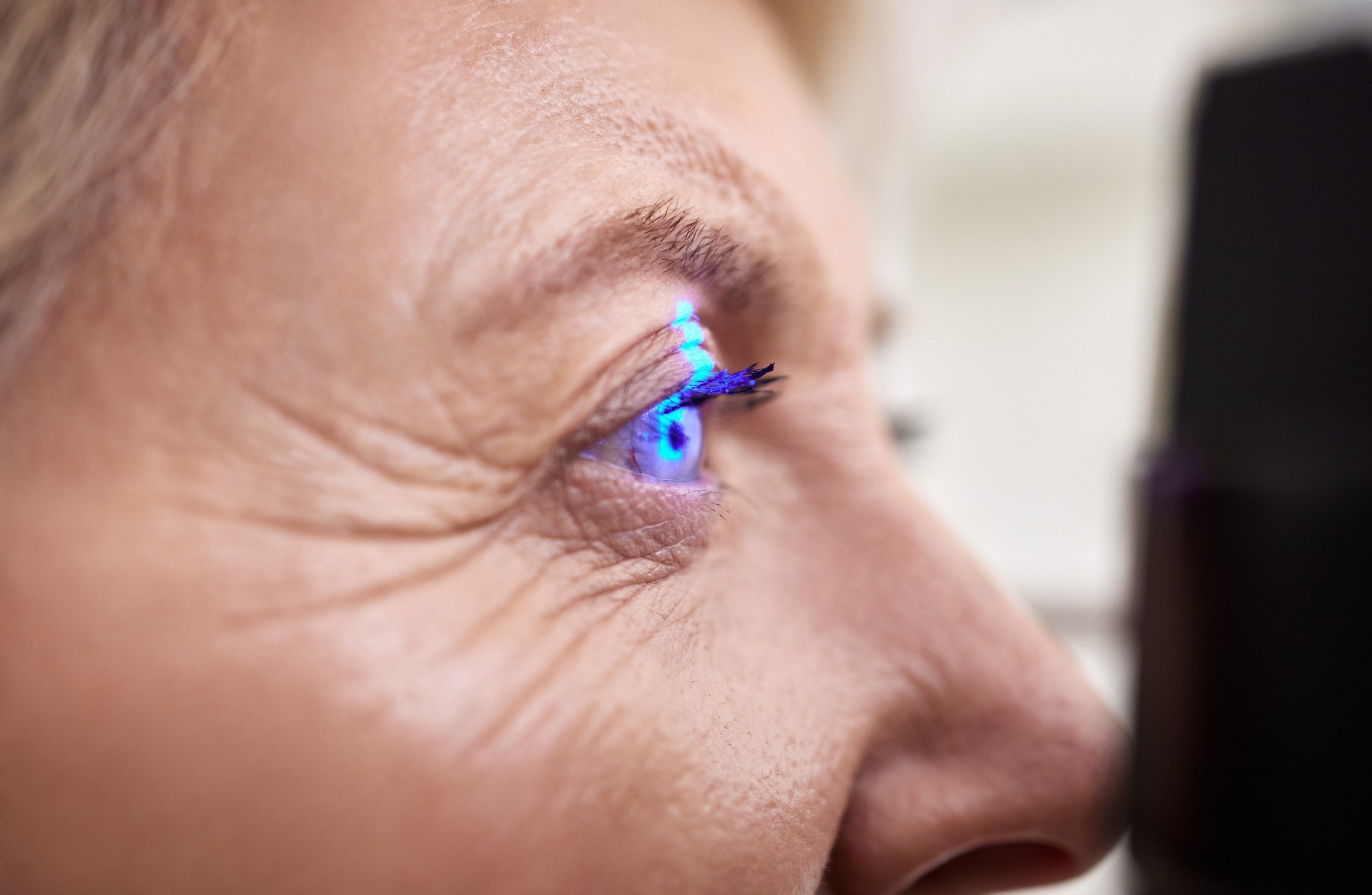In a recent study published in the Journal of Biomedical Optics, researchers demonstrate the multimodal functionality of targeted ocular fluorescence spectroscopy in vitro and in vivo.
 Study: Targeted spectroscopy in the eye fundus. Image Credit: PeopleImages.com - Yuri A / Shutterstock.com
Study: Targeted spectroscopy in the eye fundus. Image Credit: PeopleImages.com - Yuri A / Shutterstock.com
Background
Some typical structural and functional changes occur in the eyes, especially the eye fundus, due to ocular diseases like diabetic retinopathy (DR), age-related macular degeneration (AMD), and glaucoma. Neurological diseases like Alzheimer's disease (AD) and Parkinson's disease (PD) can also lead to retinal changes, such as thinning of the retinal nerve fiber layer (RNFL) and changes in hemodynamics.
Given the highly heterogeneous features and composition of the eye fundus, biomarkers either get broadly dispersed throughout this tissue or localize to specific regions. For example, β-amyloid plaques spread throughout the retina of AD patients, whereas patients with DR have localized hemorrhages.
Typical imaging techniques do not provide enough data on retinal changes induced by these diseases as compared to targeted ocular diffuse reflectance spectroscopy (DRS). Ocular DRS methods enable spectral analysis of specific parts of the eye fundus, including the optic disc, peripheral retina, and fovea between 500 and 800 nanometers (nm).
Diffuse reflectance and fluorescence spectroscopy can also elucidate the impact of factors like lipofuscin accumulation, RNFL structural changes, blood absorption spectrum, and melanin spectral profile, all of which impact the optical properties of retinal tissues.
About the study
In the current study, researchers identify the key features of the targeted ocular spectroscopy technology in vitro using a reference target and model eye. The reference target was an ultrahigh-definition screen with a grid of eight different colors, with the fundus camera positioned in front of it and only collecting light emitted by the screen. The OEMI-7 eye model, a seven mm pupil accurately simulating the human eye, helped validate these DRS acquisitions.
Subsequently, in vivo imaging and DRS were used to assess blood oxygen saturation (StO2) in the optic nerve head and parafovea of eight healthy study participants who provided informed consent before the study. These individuals were between 27 and 35 years of age, had no systemic diseases or medication, and had normal results following eye examinations.
The pointing light emitting diode (LED) illuminated the exact position of the actual region of spectral acquisition (ROSA), which allowed the camera to capture its location. A two-step acquisition sequence was used, followed by combined imaging and targeted spectroscopy.
The location of the DRS acquisition area was determined based on the ROSA image segmentation. Spectra were acquired by moving the ROSA to six different locations within the field of view of the reference target for spectral analysis.
Bandpass filters isolate the excitation illumination for green fluorescence imaging. Comparatively, long-pass filters enabled exclusive imaging and spectral acquisition of light emitted by fluorescence.
Spectral analysis involved three processing steps, wherein ambient light spectral contributions from the spectrum were removed, and the effect of the illumination source spectrum was subsequently determined. The light spectrum was then normalized to correct for differences in signal intensity.
Study findings
The model eye acquired reflectance spectra from blood vessels, the retina near the optic nerve head, the optic nerve head, and the retina far from the optic nerve head (D). The blood vessels and optic nerve exhibited clearly different reflectance spectra. Similarly, the model eye helped perform fluorescence analysis for four regions, with only the blood vessels and optic nerve head emitting fluorescence signals.
Five-second DRS acquisitions corresponded to 13 acquired spectra and were made at the optic nerve head and parafovea for all eight participants. Average absorbance spectra for both locations showed interindividual variability.
All previous methods to assess blood oxygen saturation in the eye had limited sensitivity and, as a result, allowed for the relative assessment of StO2 only for large blood vessels of the eye fundus. In the current study, blood oxygen saturation measurements made in different regions led to different values of StO2.
Lower oxygen saturation and more interindividual variability in StO2 were observed in the parafovea than in the optic nerve head, ranging from 30.4-58.4% and 62.1-69.7%, respectively.
An ocular oximetry algorithm was implemented for spectra acquired in vivo and demonstrated the potential to assess the presence of different fluorophores/chromophores that can be used to diagnose different retinal pathologies. More specifically, this approach targeted specific regions of interest that were identified through wide-field fluorescence and acquired a whole emission spectral profile of these molecules.
Conclusions
The multimodal system presented in this study enabled concurrent and continuous imaging and targeted spectroscopy in the eye fundus. Moreover, it showed high sensitivity, spectral resolution, and short acquisition speed for retinal biomarker detection. It is noteworthy because other systems, such as hyperspectral imaging, compromise between spectral resolution and acquisition speed.
Further, this technology acquired distinct spectral profiles in the different regions tested during in vitro and during in vivo testing. To conclude, targeted ocular spectroscopy could open novel ways to diagnose and treat eye diseases over time.
Journal reference:
- Lapointe, N., Akitegetse, C., Poirier, J., et al. (2023). Targeted spectroscopy in the eye fundus. Journal of Biomedical Optocs 28(12).doi:10.1117/1.JBO.28.12.126004